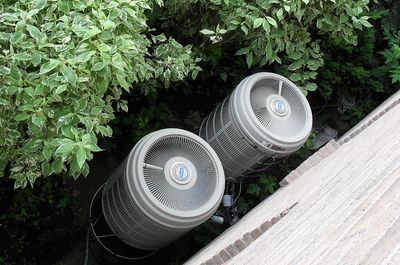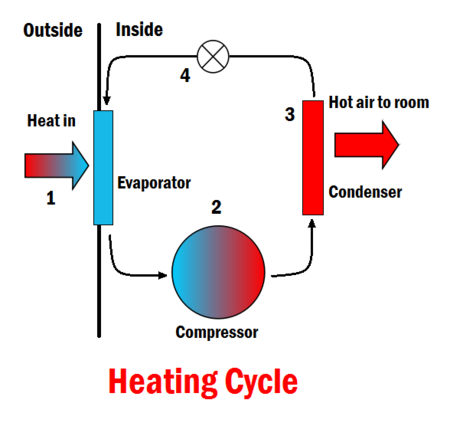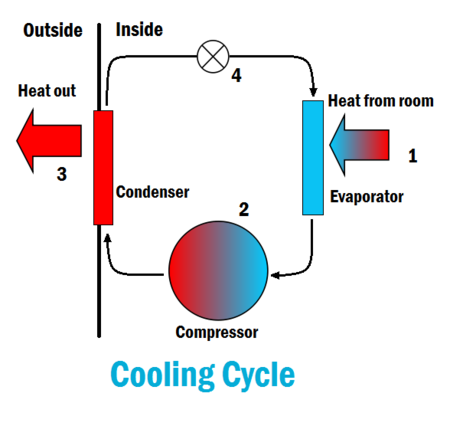Heat pump

A heat pump is a device that pulls the energy out of air for the purpose of either heating or cooling a space. This process is known as space conditioning.[2] Heat pumps operate as a heat engine in reverse, as they do work from an input of electricity to push heat from a cold place to a warm place. This would seemingly violate the Second law of thermodynamics, but the key reason it doesn't is because this heat transfer is not spontaneous; it requires an input of energy to do so. For home heating, a heat pump extracts heat from outside air, heats the warm air up even more, and transfers it indoors. For home cooling, a heat pump reverses this process and heat is extracted from the indoor air and expelled to the outside, just like a refrigerator or air conditioner, thereby making the inside air cooler.[2]
Operation
Heating Cycle
The heating cycle of a heat pump works by taking heat in from air outside, warming it up further, and using this warm air to heat indoor air. It does so by the following process:[2]
- Liquid refrigerant absorbs heat in the "evaporator" from the outdoor air, turning into a gas.
- The refrigerant is put through a "compressor", which raises the pressure of the gas, increasing its temperature.
- The hot gas flows through "condenser coils" inside the space to be heated, and since it is at a higher temperature than this space, it transfers heat to the room and condenses back into a liquid.
- The liquid finally flows back through a valve that reduces its pressure in order to cool it down so it can repeat the cycle.
This can be visualized in the picture below.

Cooling Cycle
The cooling cycle of a heat pump is used to cool a space by removing heat from it and expelling it to another area, usually to the outdoors for air conditioning or to the room for a refrigerator. To do this, the "evaporator" and "condenser coils" switch roles and the flow of refrigerant is reversed:[2]
- The cold refrigerant absorbs heat from the hotter room in the evaporator, so the room will cool down.
- It is then put through the compressor to increase its temperature.
- It passes through the condenser coils, and transfers this heat to the outside air.
- It then expands in order to decrease its pressure and cool down to below the room's temperature to repeat the cycle.
This process can be visualized in Figure 3.

Coefficient of performance
The performance of a heat pump is expressed by the ratio of heat output to the work needed to be input. Essentially, this value is how much cooling or heating is being done for a person's dollar (electricity isn't free after all). This ratio is known as the coefficient of performance (K), represented by the equation:[2]
So for heating, this coefficient is:
and for cooling it is:
where:
- is the heat input to a room to warm it
- is the heat expelled from a room in order to cool it
- is the work input as electricity
The higher the value for this coefficient is, the better a heat pump is transferring heat because it requires less work to do a certain amount of heat transfer. However, there is a limit set by the laws of entropy and the second law of thermodynamics.
Air conditioning
Air conditioning (A/C) is a system that performs on the same basic principles as heat pumps, although they do require some different components.[4] Air conditioners are not as versatile as heat pumps, because they only perform the function of cooling. However they are of more practical use in many cases, since certain places on Earth do not require heating. They function by essentially performing the same cooling cycle as heat pumps.
References
- ↑ Wikimedia Commons [Online], Available: http://upload.wikimedia.org/wikipedia/commons/4/4c/Heat_Pump.jpg
- ↑ 2.0 2.1 2.2 2.3 2.4 R. A. Hinrichs and M. Kleinbach, "Home Energy Conservation and Heat-Transfer Control," in Energy: Its Use and the Environment, 4th ed. Toronto, Ont. Canada: Thomson Brooks/Cole, 2006, ch.5, sec.G, pp.149-153
- ↑ 3.0 3.1 Adapted from Energy: Its Use and the Environment by R. Hinrichs and M. Kleinbach.
- ↑ Consumer Energy Center, Central Heating Ventilation and Air-Conditioning (HVAC) Systems [Online], Available: http://www.consumerenergycenter.org/residential/heating_cooling/heating_cooling.html

